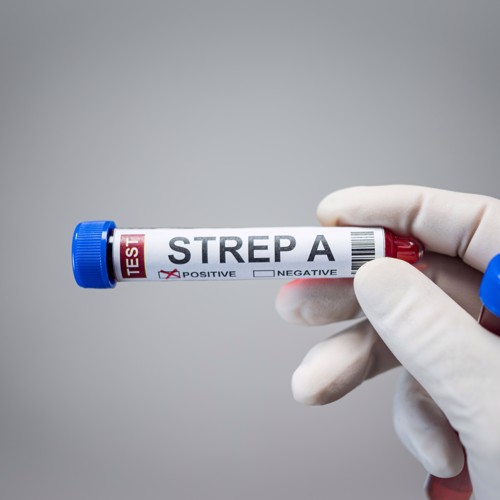Invasive Group A Strep – A Keeping it Simple Update
NO
PHARMACEUTICAL INFLUENCE
Invasive Group A Strep – A Keeping it Simple Update

With terrifying headlines reporting children dying from (iGAS) invasive Group A streptococcus it’s no surprise that parents are alarmed. A quick scrawl through the BBC news site reveals a series of articles last week with heart breaking stories of children dying. As a result clinicians in primary care, paediatrics and ED report seeing a tidal wave of parents terrified that their child’s sore throat or fever could be a sign of serious disease.
Adding to this concern, the UKHSA has confirmed this week that there has indeed been an increase in invasive Group A strep cases this year, particularly in children under 10. There were 2.3 cases per 100,000 children aged 1 to 4 compared to an average of 0.5 in the pre-pandemic seasons (2017 to 2019). So, whilst the relative risk has significantly increased the absolute risk remains incredibly low.
So, to remind us - what is iGAS and how does it present?
iGAS is caused by Group A streptococcus (GAS- Streptococcus pyogenes). GAS is a common bacterium and many people carry it asymptomatically in their throats, anogenital tract and on their skin. It can cause a range of infections including tonsillitis, pharyngitis, scarlet fever, impetigo, erysipelas and cellulitis. It is important to remember that iGAS may therefore originate from skin infection (e.g. impetigo) and not just from sore throats, RTIs or scarlet fever. There is also currently a marked increase in reports of scarlet fever.
iGAS is a rare but extremely serious complication from GAS infection. It can occur at any age, but is more likely in the very young or very old, if immune compromised or those with co-morbidities. To complicate things further, iGAS can occur as a ‘co-infection’ to a viral URTI and a high prevalence of circulating viral infections is thought to be contributing to the current increase. iGAS can also be seen in close contacts of GAS infections, such as scarlet fever, and the UK government have hinted that children in schools with GAS outbreaks may receive prophylactic antibiotics.
When invasive infection occurs, iGAS most commonly causes sepsis. This of course, we are well trained in identifying early and managing appropriately. However iGAS may also cause severe localised infections (e.g. meningitis/ cerebral abscess; pneumonia/ empyema; osteomyelitis/ septic arthritis; cellulitis/ necrotizing fasciitis; endocarditis and liver abscess) so severe pain or localising signs in one area of the body is also a red flag.
Severe iGAS infections are a medical emergency, with a risk of death reported as 15-25%. Urgent hospital transfer is essential as deterioration can occur very rapidly. Signs obviously vary according to the site, but include a persistent high fever, severe muscle aches, pain in a one area of the body and unexplained vomiting and diarrhoea.
Should we lower our threshold for antibiotics or swab throats?
Given the unusually high rates of iGAS and scarlet fever the UKHSA have sent an urgent message to all GP practices recommending a low threshold to empirically prescribe antibiotics to children presenting with features of GAS, including when secondary to viral respiratory illness. Demand is so great, we fear that a decade of great progress in reducing antibiotic use with countless consultations involving careful negotiation with parents as to why antibiotics are not needed may all be undone in a week.
The UKHSA also recommend to consider a throat swab to help with differential diagnosis, or if the patient is penicillin allergic to determine antimicrobial sensitivity or in regular contact with vulnerable individuals – there will obviously be local variations from microbiology departments on this policy recommendation. Furthermore there should be a low threshold for referral to secondary are for children presenting with persistent or worsening symptoms.
Safety netting?
The UKHSA stress the importance of safety netting, especially for parents of children with presumed viral illness. Parents should be given information about the features of secondary bacterial infection, such as clinical deterioration. The UK Health Security Agency advises ‘Anyone with high fever, severe muscle aches, pain in one area of the body and unexplained vomiting or diarrhoea should call NHS 111 and seek medical help immediately’.
The NHS and RCPCH have an updated parent information leaflet for parents with suspected GAS infection and scarlet fever, including what warning signs to look out for and how and when to seek help. The UKHSA also have an information blog for parents
In conclusion…
Although rates of iGAS are up, and the consequences can be tragic, severe disease remains thankfully very rare. We’re already seeing a lot of worried parents of children with common symptoms such as sore throat and fever. We are advised to lower threshold for antibiotics for children with suspected GAS infection, to use appropriate safety netting and to encourage early review in the case of clinical deterioration. Good luck and may your coffee be strong!
References and resources:
Drs Laura Darby & Simon Curtis
7th December 2022
Join us at one of our upcoming courses or live webinars

Recent NB Blogs
Need an immediate update? – all our courses are available on demand
Did you find this useful?
You can quickly add CPD to your account by writing a reflective note about the Invasive Group A Strep – A Keeping it Simple Update post you've read.
Log in to your NB Dashboard and use the 'Add Reflective Note' button at the bottom of a blog entry to add your note.

